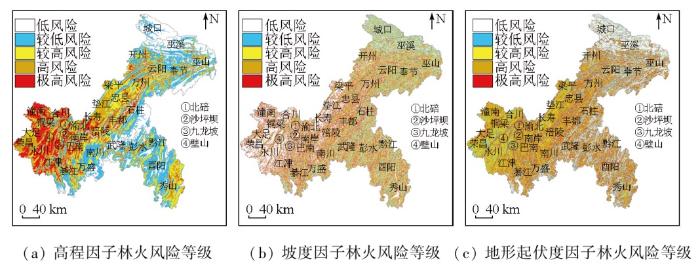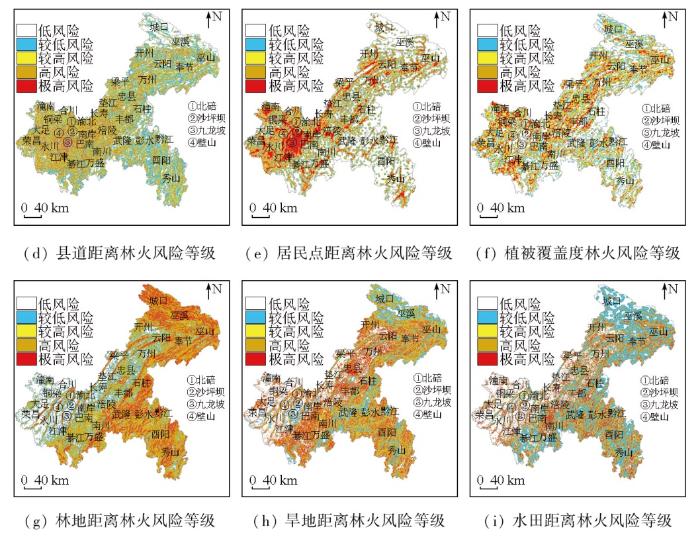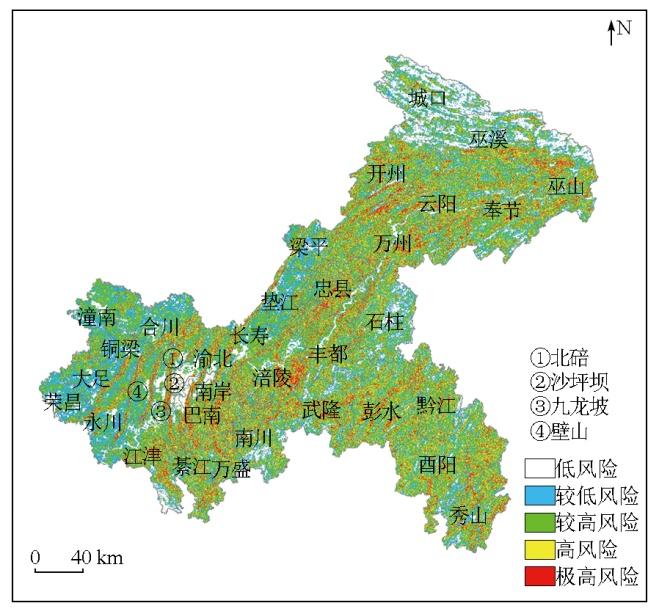0 引言
森林火灾重在预防,对森林火灾进行监测,对森林火险进行预报、预警,是落实林火“打早、打小、打了”的关键。林火的三要素包括可燃物、火源和有利的燃烧条件。可燃物包括地表死可燃物和地上活可燃物。火源包括非人为火源和人为火源,非人为火源主要来源于雷电和野外输电线路;人为火源主要是人们生产、生活用火,包括农事用火、祭祀火、野炊火和烟头等[1-
人为火源直接受人类活动及活动类型的影响,因此,人类能够到达的或用火的活动场所,如果拥有可燃物,那么这样的区域便具备了林火三要素中的两要素,即可燃物和火源,在气象林火等级高的时段,人们生产生活用火较多的林地及林地附近便成为森林火灾的高发区或诱发区。若可燃物和火源管控得当,即使在森林火险气象等级较高、燃烧条件好的情况下也能有效避免或减少森林火灾。
林火风险评估是森林火灾管理的重要组成部分,是防止和减小森林火灾危害的有效手段[12],也是林火风险综合预警的组成部分。研究中,火灾分级、过火面积、受灾面积、林种、气象因子、高程、坡向和坡度等常规的地理要素常被作为林火风险评估的因子。随着卫星遥感技术的发展,遥感反演的植被指数、植被覆盖度、干旱指数、土地分类数据和可燃物(土壤)水含量[13-14]等参数也成为了林火风险分析的主要参数,在不同地区得到了研究和应用。苏丽娟等[15]以森林火灾发生次数、火场面积、火灾成灾面积和人员伤亡及火灾的损失等数据作为分析因子,将全国森林火灾风险分为5大类,侧重评估森林火灾受灾程度;王建林[16]参照《全国森林火险区划等级》(LY 1063—92),利用农业人口密度、路网密度、气象要素(降水、气温、风速)和树种(组)作为火险的评定指标,将火险指标和研究区内林地面积的乘积与火险指标和研究区内活立木总蓄积量的乘积相加,作为森林火险等级的最终评定指标,并划分研究区林火风险等级;朱政等[17]、王双等[18]和邓欧等[19]选取气象、地形、植被、地貌分布图和人为活动等因素作为林火驱动因子,以火烧迹地和历史火点为因变量,利用Logistic模型构建林火概率模型,分别研究了昆明市、湖南和黑龙江的林火风险等级;李海萍等[20]以MODIS的火烧迹地为林火数据,以地形、植被类型及植被覆盖指数、干湿季平均温度及降水量、土地利用和人口密度等作为分析评估因子,利用Logistics构建林火风险估算模型,对凉山州林火风险进行分析;陈艳英等[21]探讨了局域地形和林火数量对重庆市林火区划的影响;郑忠等[22]增加土地分类指标、道路距离和居民点距离3个指标作为修正因子,对《森林火险气象等级》(GB/T 36743—2018)中指定的森林火险气象等级进行修正,该模型考虑了地表覆盖及人类活动对林火发生概率的影响,并对原森林火险气象等级进行了细节修正,使其预报结果更加精细化。
随着时间的推移,地形、植被类型和人类活动因子(道路网、居民点)等要素基本不发生变化,这些因子属于稳定要素,而气象要素和遥感反演的植被特征、植被含水量、干旱指数和温度场等要素,其取值随时间的变化而不断变化,这些因子属于动态要素[23]。基于稳定要素及多年平均的动态要素开展的林火风险评估结果,一般为中长期的林火风险区划[24-25],可在动态防火工作中作为林火的承载体,提升林火预警工作的针对性。本文考虑地形(坡度、高程及地形起伏度)、植被覆盖度、地表覆盖类型和人类活动因子对林火的影响,结合2000—2022年历史林火数据,对重庆市森林火灾风险进行评估,为重庆市森林防火及风险区划提供技术指导,为动态林火预警工作及研究提供林火灾害的承载体。
1 研究区概况及数据源
1.1 研究区概况
1.2 数据源及其预处理
收集2000—2022年林业部门记录的火点数据和遥感监测林火点记录,共1 206个林火点,林火点信息包含年、月、日、经度和纬度。利用GIS将林火点信息表生成点状图层数据。收集1∶5万数字高程数据,利用GIS软件,提取研究区高程参数,并计算坡度参数及地形起伏度参数。收集AI Earth提供的2000—2021年重庆土地覆盖数据集(China land cover dataset,CLCD),该数据集由武汉大学杨杰和黄昕教授团队基于Landsat影像制作。本文将坡度在8°以下的耕地定为水田,坡度在8°以上的耕地区域定为旱地,最终地表覆盖类型分为水田、旱地、林地、灌木、草地、建筑用地、水体和湿地8类。根据防火需求,将林地、灌木和草地并为林草地,分别计算历史火点与水田、旱地、林草地及建筑用地的距离。从水经注获取重庆市及外延1 km的各级道路图层,将高速路、高速引路、省道和国道划为一个路网,将县道、市区一级道路和乡镇等其他道路划为一个路网,在GIS中计算图层矩形框内所有格点与2个路网最近距离。为后期便于计算,将所有图层重采样为50 m空间分辨率。
2 研究方法
2.1 各指标因子的计算
2.1.1 地形数据
地形起伏度是描述区域地貌起伏变化的重要参数,常用某一确定面积内最大高程与最小高程之差来表示[28-29]。研究地形起伏度的关键是确定最佳统计单元以反映真实的地形起伏。结合重庆地表破碎、局地小地形丰富的现状,统计单元为1.25 km2。以数字高程模型(digital elevation model,DEM)为高程数据,在GIS中以高程数据为基础计算地形起伏度及坡度。重庆高程在15~2 737 m,坡度在0°~84°,地形起伏度在0~740 m。提取历史林火点所在像元的高程、坡度及地形起伏度。所有历史林火点所在像元的高程、坡度和地形起伏度均值分别为562.8 m,47.4°和18.2 m,其高程、坡度和地形起伏度变化范围分别为73~2 291 m,0°~68.6°和0~263 m。分析发现,林火多发生在高程和地形起伏度相对较小、坡度在20°~35°的地区。
2.1.2 地表分类数据
提取并统计历史火点与水田、旱地、林草地和建筑用地的距离,发现历史火点与水田、旱地、林草地及建筑用地的平均距离分别为235.0 m,123.0 m,154.9 m和1584.8 m,与水田、旱地、林草地及建筑用地的距离范围分别为: 0~2 907 m,0~2 381.7 m,0~2 581.2 m和0~14 154.6 m。表1给出各类土地面积比例及林火数量。
表1 不同地表类型的林火次数统计
Tab.1
| 土地覆盖 类型 | 2021年各类土地 占比/% | 林火数/次 | 林火数百分比/% |
|---|---|---|---|
| 水田 | 14.560 | 193 | 16.0 |
| 旱地 | 25.972 | 358 | 29.7 |
| 林地 | 56.697 | 603 | 50.0 |
| 灌木 | 0.340 | 9 | 0.7 |
| 草地 | 0.062 | 2 | 0.2 |
| 水体 | 0.990 | 13 | 1.1 |
| 裸地 | 0.001 | 0 | 0.0 |
从表1可见,森林火灾主要发生在林地内,且与水田、旱地的距离较近,与建筑距离在1 km附近。50.9%的林火落在林地、灌木和草地区域,且这些林火与旱地和水田的平均距离分别为204.10 m和383.47 m;剩余的49.1%的林火点主要在靠近林草地的水田及旱地中,与林草地的平均距离为346.73 m。基于距离分析发现重庆林火基本发生在与耕地较近的林区或耕地与林草地的交界处,也间接说明林火的发生与农事活动尤其是农事生产和生活用火关系巨大。
基于统计结果,对林草地距离、旱地距离、水田距离、建筑距离进行分级。将林草地距离≤50 m分成一个等级,(50,100] m分成一个等级,之后按照100 m间隔分区,1 000 m以上为一个等级。将林地距离作为约束,分成林地内(距离为0)、林地外距离500 m以内的区域、距离林地(500,1 000] m及大于1 000 m的区域,将每个分区内的旱地距离及水田距离按照50 m的间距分级。建筑用地的距离按照100 m间隔进行分区,7 km以上为一个等级。
2.1.3 路网数据
历史林火与县道等道路的路网及高速路等路网的平均距离分别为633.5 m和2 923.9 m,其变化范围分别在0~7 044.5 m及0~21 337.8 m,森林火灾与县道等级别较低的路网距离较近,而与高速路等级别较高的路网距离较远,68.49%的林火出现在距离高速路等路网1~21.34 km的区域内,且呈无序的离散分布。因此,认为高速等路网对林火不具有直接影响,在道路交通要素中,只采用县道等级别较低的路网,不采用高速路等路网。县道等路网的距离按照100 m间隔进行分区,5 km以上为一个区域。
2.1.4 植被覆盖度数据
将MODIS-Terra卫星的归一化植被指数(normalized difference vegetation index,NDVI)产品MOD13A3经过投影、格式转换、裁剪等处理后,合成年度NDVI,基于年度NDVI产品计算2000—2022年年度植被覆盖度,提取历史火点当年的植被覆盖度数据,其计算公式为:
式中:VC为植被覆盖度;
2.1.5 各要素分级结果
根据各要素的分级条件,图1给出了高程、坡度、地形起伏度、植被覆盖度、旱地距离、林地距离、水田距离、建筑及道路距离指标的分级结果,为了便于图形表达,图形分级数取统计区间的倍数。
图1
2.2 各林火风险指标独立性分析
对林火点的高程、坡度、地形起伏度、植被覆盖度、旱地距离、林地距离、水田距离、建筑及道路距离9个要素开展共线性分析,所有指标与其他指标的Pearson相关系数绝对值在0.044~0.65,均小于0.8,且共线性诊断指标VIF在1.087~1.591,小于10。因此各要素之间相对独立,不存在共线性问题,可以利用上述因子作为林火风险指标,建立林火风险分区综合指标。
3 基于多要素的林火风险分区
3.1 林火风险指标计算
3.1.1 地形要素的林火风险指标计算
分析发现,高程、坡度、地形起伏度指标与林火次数在空间上大多呈2段分段函数的关系,高程的分段区间分别为≤240 m及>240 m;坡度的分段区间分别为≤30°和>30°;地形起伏度的分段区间分别为≤60 m和>60 m。在分段区间内分别建立林火风险分段函数,并在此基础上分别计算高程、坡度、地形起伏度的林火风险指标。至此得到地形要素的林火风险空间化指标,高程、坡度及地形起伏度与林火数量间的分段拟合见图2。
图2
图2
林火次数与地形要素的关系
Fig.2
The relationship between the number of forest fire and the topographic indexs
3.1.2 土地利用类型的林火风险指标计算
表2给出与林地不同距离区间内林火发生概率及区间内林火点与林草地、旱地、水田的平均距离。
表2 林地不同距离区间内林火次数及其与水田、旱地距离的关系
Tab.2
| 林火与林地 距离/m | 林地平均 距离/m | 水田平均 距离/m | 旱地平均 距离/m | 林火数/次 | 林火 占比/% |
|---|---|---|---|---|---|
| 0 | 0.0 | 383.0 | 204.0 | 614 | 50.9 |
| (0,500] | 149.1 | 92.6 | 31.2 | 481 | 39.9 |
| (500,1000] | 618.6 | 33.5 | 67.5 | 66 | 5.5 |
| >1000 | 1 606.0 | 26.0 | 77.0 | 45 | 3.7 |
从表2发现50.9%的林火发生在林地内,且随着与林地距离的增加,林火数量呈现下降的趋势;且林地内的火点与旱地、水田的平均距离在400 m以内;另外49.1%的林火发生在林草区以外,距离旱地、水田的平均距离在100m以内,其中落在耕地的火点占林火总数的45.7%,这是由于重庆地表破碎,林草地与其他用地类型的交界处多为混合像元,加之林火点的定位精度不足,部分交界处用地类型产生了变更,因此混合像元内的火点被判别为其他用地类型(以耕地为主)。以上分析也说明了林火主要发生在靠近耕地的林草区及耕地与林草区的交界处。按照区间分析,建立林火与林草地距离、旱地距离、水田距离的关系(见图3),得到林草地距离林火风险指标、旱地距离林火风险指标和水田距离林火风险指标。
图3
图3
林火次数与林草地距离、水田距离及旱地距离的关系
Fig.3
The relationship between the number of forest fire and the distance of forest and grassland, dry land and paddy
3.1.3 人类活动因素的林火风险指标计算
林火与县道、一级道路及其他道路平均距离为634 m,出现在距离县道、一级道路及其他道路1 km以内的林火976次,占总数的81.00%,其中发生在500 m内的林火占总数的76.30%。林火数与县道、一级道路及其他道路的距离呈现分段函数关系,基于分段函数计算(0,500]m及(500,5 500]m 2个区间内的林火风险指标,见图4。林火与居民点的平均距离为1 584.8 m,2 km以内的林火占总数的71.81%,随着距离的增加,林火数量减少,在7 km以内的区域,林火数量与距离呈现显著的指数关系,在距离大于7 km时,林火偶有发生,距离大于10 km时,基本无林火发生。
图4
图4
林火次数与县道距离及居民点距离的关系
Fig.4
The relationship between the number of forest fire and the distance to buildings and county roads
3.1.4 植被覆盖度因素的林火风险指标计算
提取林火与林火发生年相对应的植被覆盖度可发现,植被覆盖度与林火次数呈现分段的指数函数关系,植被覆盖度≤66%时,为增函数,当植被覆盖度在66%以上时,随覆盖度的增加,林火次数逐渐降低(图5)。依此得到植被覆盖度林火风险指标。
图5
图5
林火次数与植被覆盖度的关系
Fig.5
The relationship between forest fire number and vegetation coverage
3.1.5 林火风险指标空间化
为了便于风险等级划分,对各因子风险值采用累积密度的方式进行归一化处理,归一化处理后各风险因子取值范围在0—1之间,图6给出了高程、坡度、地形起伏度、植被覆盖度、林地距离、旱地距离、水田距离和建筑及道路距离各指标的林火风险分布。
图6-1
图6-1
单要素林火风险等级划分
Fig.6-1
Classification of single factor forest fire risk levels
图6-2
图6-2
单要素林火风险等级划分
Fig.6-2
Classification of single factor forest fire risk levels
3.2 林火风险分区及结果检验
采用CRITIC法计算各要素的权重指标,各要素的权重见表3,其中林地、旱地及植被覆盖度对林火风险的贡献居前3位,高程、坡度及起伏度则偏低。
表3 各林火风险指标的权重值表
Tab.3
| 指标 | 权重/% |
|---|---|
| 高程 | 9.71 |
| 坡度 | 8.77 |
| 起伏度 | 9.68 |
| 植被覆盖度 | 12.67 |
| 道路距离 | 10.21 |
| 建筑距离 | 11.55 |
| 林地距离 | 13.42 |
| 林地约束下的旱地距离 | 13.00 |
| 林地约束下的水田距离 | 10.79 |
基于表3的权值计算林火风险分区指标,得到林火风险空间分布结果,计算林火风险空间分布图的均值mean及标准差std,依据均值和标准差将林火风险等级分为低风险区(≤mean-1std)、较低风险区(mean-1std,mean]、较高风险区(mean,mean+0.5std]、高风险区(mean+0.5std,mean+1std]、极高风险区(>mean+1std)5个等级,林火风险空间分布见图7。从图7可见,重庆市林火风险等级与地形走势、土地利用及人类活动关系密切,高风险区及极高风险区主要分布在与人类活动较近的中低山的林地区域;同时,在与林地距离较近的耕地、建筑、墓地周边多混合用地,多生产生活用火,也是诱发林火的高风险区域;另外,与林地较近的道路多车辆行人丢弃的烟头等火源,容易诱发林火。林火的低风险区主要分布在距离居民点、耕地、道路等人类活动稀少的高山林地及建筑用地、水体等非林区。
图7
依据林火风险评估分区结果及历史火点数据,在GIS中提取火点所在格点的林火风险指数,统计各个林火风险等级对应的历史林火数量,并计算各风险区的林火占比,其中低风险区和较低风险区的林火次数较少,分别占8.33%和8.67%。低风险区的林火一部分落在建筑用地及其附近,这部分林火主要受城镇扩张影响,土地利用类型由林地变更为建筑用地,而建筑用地多为林火低风险区;一部分落在高山林地,这部分林火主要受雷击或高压线漏电引燃,这些林火远离人类活动区,发生频率相对偏低,因此在本文的分区因子中,属于低风险区域。较高风险区及以上等级区域的林火占比为83%,其中较高风险区、高风险区和极高风险区林火分别占22.72%,35.13%和25.15%。
4 结论及展望
1)本文以高程、坡度、地形起伏度、植被覆盖度、道路距离、居民点距离及表征地表覆盖的林地距离、旱地距离、水田距离作为林火风险分析的自变量,以历史林火点作为因变量,将各自变量划分等级,统计等级区间内的林火数量,分析了数林火数量与各因子之间的关系,得到单因子林火风险指标及空间分布结果。利用CRITIC法计算各单因子林火风险指标的权重值,依据加权法计算风险指标得到林地、旱地及植被覆盖度对林火风险贡献度居前3位,高程、坡度及地形起伏度的贡献度则偏低。利用风险指标的均值及标准差将林火风险分为低风险、较低风险、较高风险、高风险和极高风险5个等级。
2)重庆市林火风险与地形走势、土地利用及人类活动关系密切,林火的高风险区及极高风险区主要分布在人类活动频繁的中低山林区附近,耕地、乡土路、住宅及墓地较近的林地周边区域生产、生活用火较多,易诱发林火,也属于高风险区域;低林火区域主要分布在地势低平的非林区及山势陡峭的林区,建筑用地、水体及距离林地较远的水田、旱地等区域也属于林火低风险区。统计各个林火风险等级对应的历史林火数量表明: 83%以上的历史林火发生在较高风险、高风险及极高风险区; 17%的林火在低风险及较低风险区。
3)林火风险评估的关键在于风险指标的计算及综合指标的获得,考虑到研究区存在地形复杂、地表覆盖破碎的特点,采用分段函数的方法计算单因子风险指标,以此展示研究区的区域差异性。利用CRITIC法计算权重指数得到综合风险指标,体现了林火影响因子的重要性排序。
在本文林火风险评估工作做中,没有考虑林地的种类、林地的年龄、可燃物类型等具体因素,后续的研究可将这些数据作为林火风险评估因子,体现林地性质对林火风险评估结果的影响。
参考文献
森林火灾人为火源因素影响程度的主成分分析
[J].
Principal component analysis of man-made fire sources in forest fires
[J].
清顽疾,专项治理野外火源
[J].
Clear the stubborn disease and treat the wild fire source specially
[J].
2008—2018年我国森林火灾事故统计分析
[J].
Statistical analysis of forest fire accidents in China from 2008 to 2018
[J].
2000—2022年我国林火主要致灾因素及扑救伤亡原因分析
[J].
Analysis of dominant causes and rescue casualties of forest fires in China from 2000 to 2022
[J].
1981—2020年广西森林火险气象等级特征及成因分析
[J].
Analysis of meteorological grade characteristics and causes of forest fire risk in Guangxi from 1981 to 2020
[J].
中国森林火灾发生特征及其与主要气候因子的关系研究
[J].
Study on the characteristics of forest fires in China and their relationship with major climatic factors
[J].
高森林火险天气形势及其前期气候特征与预报
[J].
Weather situation with high forest fire risk and its climatic characteristics and forecast
[J].
大兴安岭森林火险季节动态特征及其气候条件分析
[J].
Seasonal dynamic characteristics and climatic condition analysis of forestry fire risk in Daxing’an Mountains
[J].
皖南山区乡镇森林火险气象预报等级模型探讨
[J].
Discussion on meteorological forecast grade model of forest fire danger in villages and towns in southern Anhui mountainous area
[J].
林火研究综述(Ⅱ)——林火预测预报
[J].
Forest fire research(Ⅱ):Fire forecast
[J].
1950—2010年中国森林火灾时空特征及风险分析
[J].
Temporal and spatial characteristics and risk analysis of forest fires in China from 1950 to 2010
[J].
永安市森林火险等级区划研究
[J].
Study on the forest fire danger class division of Yong’anCity
[J].
昆明市林火驱动因子及火险区划研究
[J].
Driving factors of forest fire and fire risk zoning in Kunming City
[J].
基于空间logistic的湖南省森林火灾风险评价
[J].
Assessment of forest fire risk in Hunan Province based on spatial logistic model
[J].
基于空间Logistic的黑龙江省林火风险模型与火险区划
[J].
Model and zoning of forest fire risk in Heilongjiang Province based on spatial Logistic
[J].
基于Logistic模型的四川凉山州森林火灾风险分析
[J].
Analysis of forest fire risk in Sichuan Liangshan based on Logistic model
[J].
局域地形和林火数量对区划方法的影响规律研究
[J].
Research of forest fire zoning based on local topography and fire numbers
[J].
西南山地区域森林火险综合预报模型研究——以重庆市为例
[J].
Research on the construction of composite risk prediction model for forest fire in the mountainous area of southwestern China:Taking Chongqing City as an example
[J].
基于可变模糊集方法的森林火险区划研究
[J].
Study on forest fire danger division based on variable fuzzy sets method
[J].
我国北方森林草原地区火险等级遥感评估及时空特征分析
[J].
Fire danger rating assessment and spatial-temporal characteristic analysis of forest and grassland in North China using remote sensing
[J].
重庆市森林火灾时空分布特征分析
[J].
Analysis on temporal-spatial feature of forest fires in Chongqing
[J].
DOI:10.11924/j.issn.1000-6850.2013-2849
[本文引用: 1]

In order to provide scientific guidance for forest fire prevention, improve effectiveness of forest fire prevention, to reduce the fire loss, 679 forest fire cases containing date of records (among these data, 654 and 602 data respectively recorded start and end hour of forest fires) were used to analyze temporal feature, and 527 fires used to analyze spatial feature owing theirs latitude and longitude information. All the fire data were from 2000 to 2010 year in Chongqing. The results of calculation showed as following: (1) there were 61.7 forest fire annually during 2000-2010 year and the number of forest fires increased when drought occurring. (2) The forest fires occurred most frequently during spring, and the number was least Autumn, respectively second and third in winter and summer. (3) The forest fires mainly occurred in 4 months including February, March, April and August, and in November and December the fires were very rarely. (4) The start and end time of forest fires occurred mainly between 9 a.m. and 8 p.m, while between 9 p.m and 8 a.m very rarely. (5) Most forest fires’ duration was not long, and there was a negative exponential relation between duration and forest fire number. (6) The spatial distribution of forest fires varied with terrain height. In wild higher ground, more forest fires distributed at relatively lower piedmont area, while in wild lower ground, the more forest fires distributed at relatively higher mountain ridge. (7) The forest fire division was 6 grades according its number, and they were most easily occurring district, easily occurring district, generally occurring district, lower occurring district, rarely occurring district and not occurring district.
四川凉山州的森林火灾遥感监测研究
[J].
Remote sensing monitoring of forest fire in Liangshan Prefecture,Sichuan Province
[J].
基于地形起伏度的山区人口密度修正——以岷江上游为例
[J].
DOI:10.13249/j.cnki.sgs.2015.04.464
[本文引用: 1]

山区人口承载能力评价是山区国土空间管理的基础之一,而准确的人口密度数据是正确评价人口承载能力的基础。传统的人口密度算法并未考虑地形起伏度对人口分布带来的影响,不能客观反映山区人口聚集程度。引入地形起伏度、海拔高度因子,选择岷江上游作为研究区,首先运用GIS技术提取地形起伏度,再运用SPSS软件对人口密度与地形起伏度相关性进行分析,确定县域不同地形起伏度与海拔人居适宜标准,剔除阈值以外不适宜人口聚居的面积,对人口密度进行修正。研究结果表明:① 岷江上游人口分布受地形起伏度的影响显著,二者的对数曲线拟合度为0.89,汶川县、茂县、理县、黑水县与松潘县地形起伏度与人口分布的相关性分别为:0.841、0.773、0.643、0.696和0.730;② 应用地形起伏度对岷江上游人口密度修正,为真实反映山区人口密度提供了新的考量依据,剔除了人口密度空间噪音,5县地形起伏度与海拔适宜标准分别为:汶川3.2°和3 693 m,茂县4°和4 033 m,理县4.3°和3 790 m,黑水4.4°和3 853 m、松潘4.2°和3 966 m;地形起伏度高值区面积越大,修正前后的人口密度偏差越大,地形起伏度较大的理县和黑水县修正后的人口密度分别提高了7.8倍和5.6倍;地形起伏度较低的汶川县与茂县修正后人口密度仅分别提高2.3倍与2.4倍;③ 岷江上游人口潜在压力大,不同区域应因地制宜,汶川和茂县采取重点集约发展战略,理县和黑水县采取适度开发战略,松潘县应采取恢复与保护生态策略。
Population density correction method in mountain areas based on relief degree of land surface:A case study in the upper Minjiang River Basin
[J].
DOI:10.13249/j.cnki.sgs.2015.04.464
[本文引用: 1]

A prerequisite for the protection and governance of mountainous areas is the scientific evaluation of the population carrying capacity, which depends on an accurate assessment of population density. The prior method of calculating population density does not consider the effect of the relief degree of land surface (RDLS) on population distribution. Therefore, it cannot accurately reflect the degree of population aggregation, especially in mountainous areas. Thus, this study selects the Upper Minjiang River Basin as the research area and introduces the RDLS and elevation factor. First, it extracts the exact population value by means of geographic information system technology. Second, it conducts the correlation analysis between the population distribution and the RDLS by using the Statistical Package for Social Science (SPSS). Then, based on the correlation and the population distribution analysis, this method is used to determine the appropriate standard of RDLS and elevation in different mountainous areas. According to the corresponding results, it calculates and corrects the population density of the upper Minjiang River Basin. The results show that: 1) The population distribution of the upper Minjiang River Basin is strong affected by RDLS, correspondingly, the R2 value between the RDLS and the population of the upper Minjiang River Basin is 0.89. The correlation coefficients between the RDLS and the population density of different county (Wenchuan county, Mao county, Li county, Heishui county and Songpancounty) are 0.841, 0.773, 0.643, 0.696 and 0.730, respectively. 2) The RDLS and elevation are introduced to revise the population density in the upper Minjiang River Basin. According to the results of the population cumulative distribution curve, the rational RDLS for human habitation in Wenchuan County, Mao County, Li County, Heishui County and Songpan County are 3.2°, 4°, 4.3°, 4.4° and 4.2°, respectively. The corresponding elevation is 3 693 m, 4 033 m, 3 790 m, 3 853 m and 3 966 m. 3) The population density has been corrected is clearly different from the previous result. The higher RDLS of mountainous areas, the more obvious discrepancy exists. For example, compared with previous result, the revised population density in Li County and Heishui County increase by 7.8 and 5.6 times, respectively. In contrast, the revised population density in Wenchuan county and Mao county increase by 2.3 and 2.4 times, respectively. 4) The upper Minjiang River Basin is confronted with greater pressure of population growth. Thus the population distribution of this area should be guided by local social, economic, topographic and other conditions. Specifically, Wenchuan county and Mao county should adopt intensive development strategy, Li County and Heishui County should adopt moderate development strategy and Songpan County should adopt ecology repair strategy.
新疆地势起伏度的分析研究
[J].
Analysis of the relief amplitude in Xinjiang
[J].
中国陆地1∶100万数字地貌分类体系研究
[J].地貌分类体系是地貌图研制的关键之一,本文在总结国内外地貌及分类研究的基础上,借鉴20世纪80年代的中国1∶100万地貌图制图规范,基于遥感影像、数字高程模型和计算机自动制图等技术条件,归纳总结了数字地貌分类过程中应遵循的几大原则,分析了它们之间的相互关系,讨论了数字地貌分类的各种指标:包括形态、成因、物质组成和年龄等,提出了中国陆地1∶100万数字地貌三等六级七层的数值分类方法,扩展了以多边形图斑反映形态成因类型,以点、线、面图斑共同反映形态结构类型的数字地貌数据组织方式,并详细划分了各成因类型的不同层次、不同级别的地貌类型。中国1∶100万数字地貌分类体系的研究,为遥感等多源数据的陆地地貌解析和制图提供了规范,也为《中华人民共和国地貌图集》的编制奠定了基础,同时为全国大、中比例尺地貌图的分类和编制研究提供了借鉴。
Research on the classification system of digital land geomorphology of 1∶1 000 000 in China
[J].
山地丘陵区土地利用分布及其与地形因子关系——以河北省怀来县为例
[J].
DOI:10.11821/dlyj201505010
[本文引用: 1]

为探究山地丘陵地区不同地形因子对土地利用空间格局的影响,以河北省怀来县为例,研究了各土地利用类型在不同地形上的分布特征。同时,定性和定量分析了土地利用景观格局与地形环境的相关性。研究表明:土地利用景观格局分布存在明显的地形梯度特征,较高地形级别主要分布着林地和草地,其分布指数在较高地形级别占据优势位;而受人类活动干扰影响较大的城乡建设用地、采矿用地、耕地、园地和水域的优势位分布在较低地形级别上。移动窗口法得到的景观格局指数的分布定性显示出土地利用景观格局随地形变化的梯度特征,典范对应分析结果定量显示出典范对应分析排序的前4个轴的累计土地利用景观指数—地形解释变量为96.98%,地形因子第1排序轴与土地利用变化景观格局指数特征第一排序轴的相关系数达到0.671,其土地利用景观格局指数与地形因子存在显著的相关性。由此可见,高程、坡度和地形起伏度这三类地形因子对山地丘陵区的土地利用类型的结构和空间分布起着重要的影响作用。
Spatial distribution of land use and its relationship with terrain factors in hilly area
[J].










